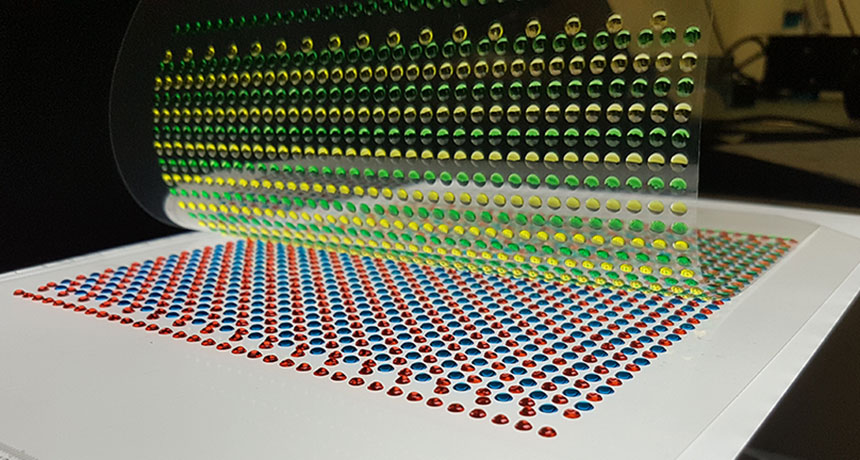Health monitors, pacemakers, mechanical prosthesis and internal drug dispensers all depend on power. The challenge is either making self-activating devices independent of electricity, or finding a way to implant a battery inside the body.
In a project supported by the U.S. Air Force Office of Scientific Research and National Institutes of Health, electric eels have sparked the creation of 3D printed hydrogel power sources. Taking on the form of rainbow colored discs and droplets, the gels present the potential to be accepted within the body almost as naturally as water.
A delicate balance
The soft power sources in this research all work on the same principle. Hydrogel droplets or discs are made from a mixture of water, sodium and chloride (basic table salt) that serves as a battery’s electrolyte. Created in low and high concentrations, the electrolytes are represented in examples as blue and red respectively. Positive and negatively charged ion solutions that dissolve the sodium and chloride are also made as yellow and green gels.
By alternating the placement of each of these four gels, the researchers create a combination capable of transmitting a low electrical current, which can be turned on and off by separating the gels.
Currently, contact between the gels is made manually, in one case using a sheet of polymer laser-cut to fold like origami. In the future, self-actuating 4D printed polymers could be considered by the team.

The electric holy grail
Gels are made using a 3DDiscovery printer from regenHU – a system that first deposits the gels as ink droplets, then cures them into a solid. Precise gel placement was also tuned with the help of F. Bircher’s iPrint institute at the Haute École d’Ingénierie et d’Architecture Fribourg, Switzerland.

Currently, the hydrogel arrangement is incapable of creating a charge that matches the likes of an electric eel, though it may be enough to power a pacemaker. Michael Mayer, co-author of the study and professor of biophysics at both the University of Fribourg and the University of Michigan, explains, “The electric organs in eels are incredibly sophisticated; they’re far better at generating power than we are.”
“But the important thing for us was to replicate the basics of what’s happening.”
The team continue to develop new configuration of the materials to produce the desired charge and performance. Mayer adds, “The holy grail, at least to me, would be to design this thing so it can recharge itself inside the body.”
An electric-eel-inspired soft power source from stacked hydrogels is published online in Nateure Letters. It is co-authored by Thomas B. H. Schroeder, Anirvan Guha, Aaron Lamoureux, Gloria VanRenterghem, David Sept, Max Shtein, Jerry Yang and Michael Mayer.
Nominate the best healthcare innovations in the the second annual 3D Printing Industry Awards now.
To be the first with all the latest 3D printer releases, subscribe to the free 3D Printing Industry newsletter, follow us on Twitter, and like us on Facebook.
Featured images shows multicolored hydrogel discs laid on top of one another create an electrical current. Photo by Thomas Schroeder


